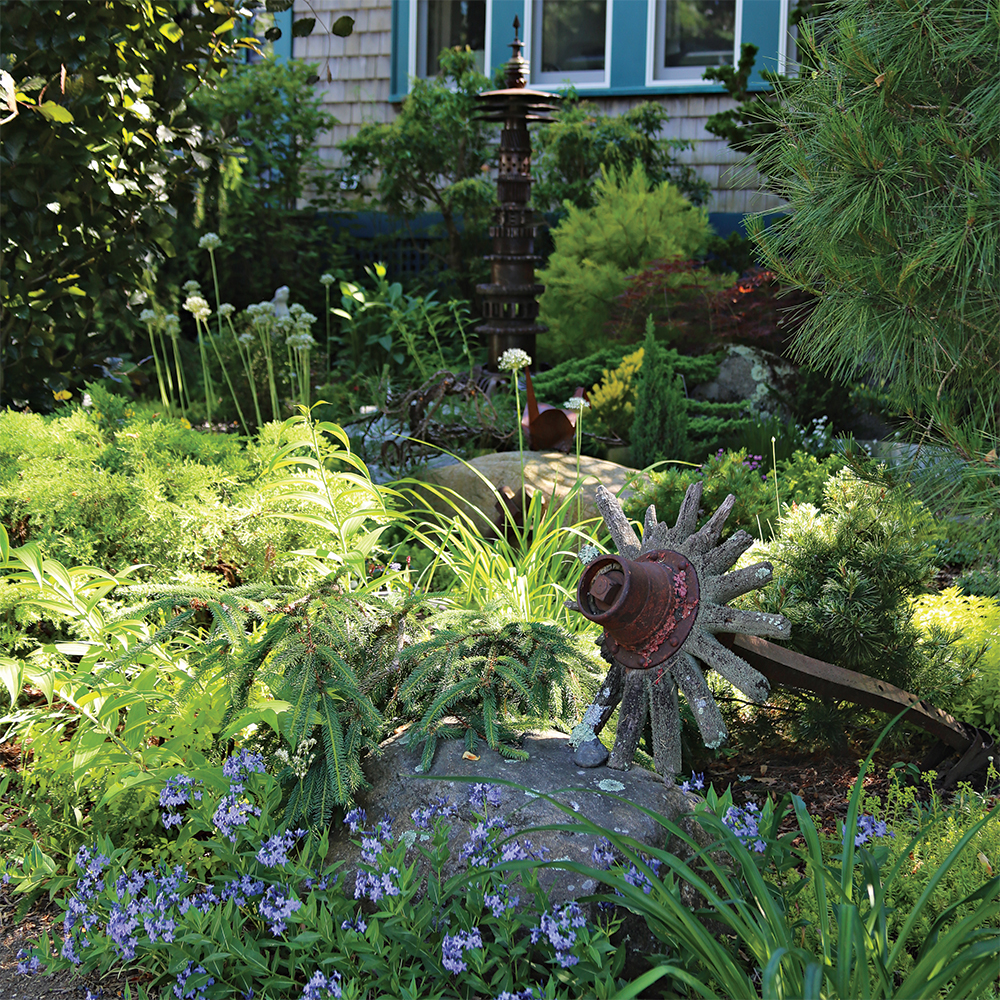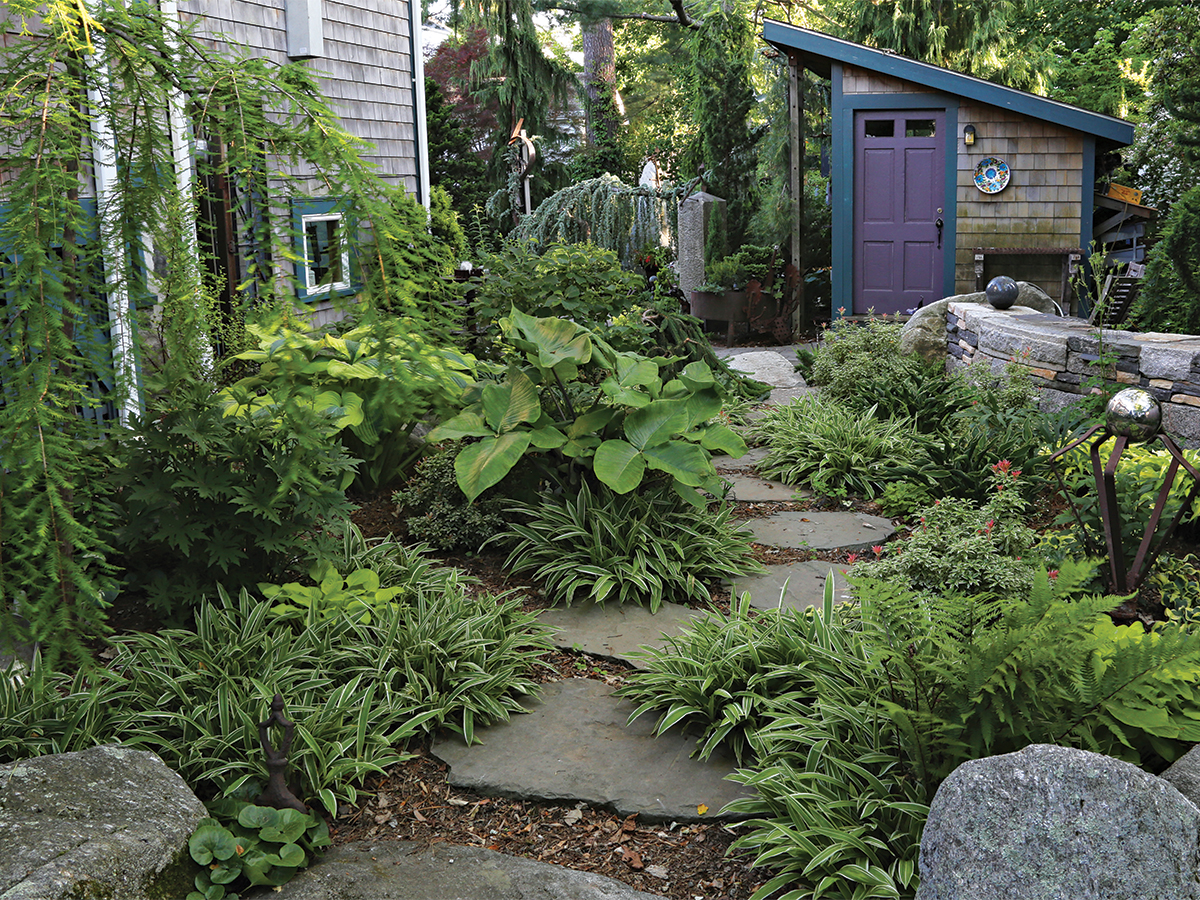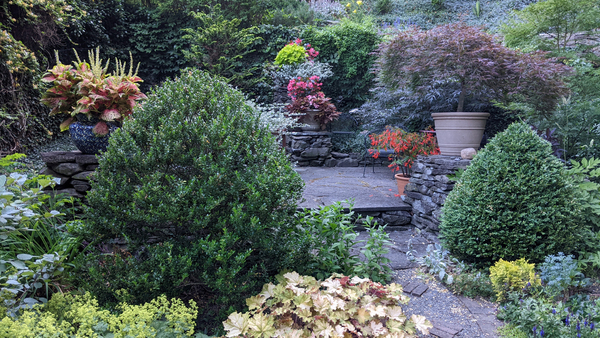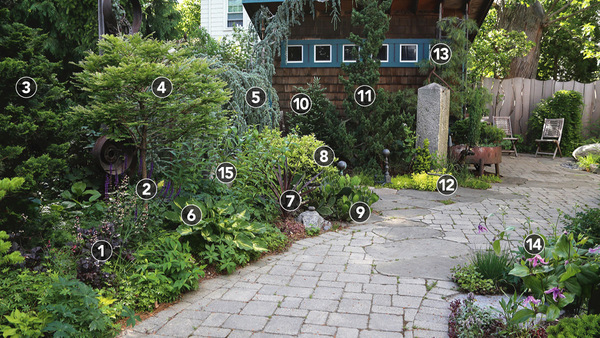
Most gardeners get into gardening because they collect plants. While I am thoroughly addicted to plants—I dream about them, buy them, and plant them—I am also addicted to stone and rusty objects. A garden by my definition is a three-dimensional outdoor space that must first provide for the spatial needs of people. If the space is so stuffed with plants that there’s no room to move or enjoy the outdoor venue, what’s the point? For me, a landscape needs to be functional and practical before I worry about what plants go where. Because of this, I believe that the hardscaping underpinning a space is as vital as the plants.
Visualize the spatial flow to help place the hardscape

When my wife, Patti Ryan, and I started to create our garden in 2006, I took a different approach than many would when it came to getting started. Rather than buying plants and plunking them down here and there, I surrendered and drew out a design plan. Faced with a wide blank slate, I divided the space into sections, giving equal planning attention to the hardscape and the planting areas. I wanted to limit the physical and visual access between the sections so as to make our small urban yard feel more expansive. Before deciding where to put a path, I not only considered the practical function of getting from point A to point B, but I thought about the multitude of focal points along the way, including the destination. While every functional walkway should have an interesting end point—a seating area or our shed, for example—it is the journey to get there that enriches the experience.
I also used asymmetrical placement of focal points, putting them slightly off center to pique a visitor’s interest in peeking around the corner. An example of this is our front Japanese-style gate, which announces the gracious entrance from the house/driveway to the back garden and patio. The gate itself serves as a “frame” that was placed slightly askew to allow only a limited view of a small raised bed and patio area beyond. I tried to strike a careful balance between appealing visual barriers and tall, heavy walls that make visitors feel claustrophobic.
The beauty of having a fully conceptualized plan is that as we built each part, we were able to fit in the next part like a puzzle. I expended the same kind of creative thought and planning to the selection of hardscaping materials and placement that I would with the planting design. This ensured that the structure of the garden was both functional and remarkable.
Select plants for shade repetition or color and texture contrast
When it came to choosing plants, I followed the same principles I used in choosing my hardscape materials, with an emphasis on sculptural habits and interesting textures. As a member of the American Conifer Society, I have ACS (addicted conifer syndrome), and my garden showcases about 100 different conifers as well as many Japanese maples—both of which have amazing habits and textures. Then I mixed in an array of perennials selected because they provided color or textural contrast.

With my propensity to see the sculptural qualities of plants, I determined plant placement by playing off of the hardscaping or various objects throughout the space. For instance, the tiered branching of Japanese white pine (Pinus parviflora ‘Glauca’, Zones 6–9) echoed the tiers of our disc-harrow water feature. Nearby, a weeping Norway spruce (Picea abies ‘Pendula’, Zones 3–7) provided a low, cascading silhouette. It was the perfect choice to flow down the smooth boulders (like water) into our dry pond. Here the plants and sculpture knit together to create similar shapes and visual repetition.
At the front of the house are more colorful plants. These were chosen with a contrast in mind, however. I wanted to draw the eye toward the interesting objects found here that might otherwise be missed. A mass of ‘Blue Ice’ bluestar (Amsonia ‘Blue Ice’, Zones 4–9) catches your attention first in this spot, but then you notice the playful wagon wheel hovering above like a flower. Various yellow-variegated conifers and similarly colored perennials play a comparable role in pulling the eye toward the Japanese pagoda sculpture a few feet away. I continue to trial different plants in our garden and refine the collective visual experience of each vignette using shape repetition or color and texture contrast.
Accent the garden with other materials

Once the hardscape was in and the planting areas were filled, Patti and I started to decorate the garden with pieces of iron and other objects (which is yet another level of hardscape). We used these as focal points, hidden surprises, and tongue-and-cheek bits of humor. But most importantly, these objects provided a structural layer that animated the garden year-round.
To place the objects in the garden, I used much the same sort of visual and experiential sensibility that I use with plants, taking into account the shape, color, density, and texture of each object. A cache of organ pipes turned out to be the perfect choice to stand behind the seating wall of the patio in descending height; this emphasizes the circular shape of the patio and forms a bridge from the taller height of the trees along the property line down to the patio. These pipes act as a visually opaque backdrop. I could have used a hedge or row of ‘Sky Pencil’ Japanese holly (Ilex crenata* ‘Sky Pencil’, Zones 6–8) to do this also—but life is short, so why not have fun? Farm equipment and industrial castoffs became integral elements of various vignettes in the garden. We even created a custom railing out of pieces of pipe to look like vines for our front entry. The railing blends in quite well with the surrounding garden and generally guarantees a chuckle and a second look from visitors.
Tip: Mix and match materials like you would plantsI like to punch one hardscape material into another—much like layering different plants next to each other for a composite effect. So I used pieces of reclaimed granite and cut bluestone to piece into the concrete paver walkway. I also mixed boulders and reclaimed granite slabs to use as sentinels in the garden. These assorted stones are permanent structures that serve as focal points year-round. |

The consistent use of rusted metal in the garden is another repeated color, like the green provided by plants, and gives the entire landscape cohesion. As your eye surveys the garden, you see green and rust as unifying hues, and then you assess their shapes. Viewers can get as much pleasure from a perfect plant as they can from a perfect rusty andiron. Stone (primarily gray granite) also provides a consistent color and texture that unifies the garden.
I am always looking at our hardscape, objects, and plants in a new light. Much like any gardener, I move plants to make a better visual impact, and I do the same for our objects. Luckily, the objects don’t have sun or shade requirements. Last summer I redesigned the dry pond, taking the jumble of Japanese river rocks that had been beckoning to me and carefully laying them like a tapestry. Now they ripple as if droplets of water have kissed the surface of the water (photo right). The combination of hardscape elements, stone and iron objects, and unique plants creates a depth of dimension that is hard to achieve only with plants. This is what makes the garden entrancing, to us and visitors alike.
Garden art or junk? Sometimes it’s all about placement
We treat the various sculptures, found objects, and upcycled art in our garden as yet another layer of hardscape. The assortment and number of these treasures doesn’t seem all that overwhelming because of their careful integration into very specific areas of the garden. Here are descriptions of a few favorite pieces, where they live, and why their placement is important.
1. Floor lamp flowers
Patti made these from the metal shades of floor lamps. Individual floral “stems” are gathered into two arrangements on the right and left of the side-path entrance to the garden. They pull people out of their cars upon arriving at our house. Nothing says to guests they are welcome like bunches of flowers.
2. Disc harrow fountain
We did not want to care for a pond with fish and deal with all the maintenance that comes with a large-scale water feature. So our mason, Jose Florez, created this option for us out of upturned farm discs from an old harrow. We get to enjoy the sound of water now, without nearly as much upkeep. Clear glass fishing floats give some extra glimmer. Somewhat ironically, the feature stands above the dry pond and stone bridge.
3. Dancing geisha
This sculpture was welded by Patti. Made from upcycled bike rims, a shovel head, and various drill bits, this geisha greets visitors who take the path around and behind the back patio. She offers a silent but poised head nod in her role as an unexpected focal point.
*Invasive alert: Japanese holly (Ilex crenata)
This plant is considered invasive in NJ and TN.
Please visit invasiveplantatlas.org for more information.
Christie Dustman has been a landscape designer for over 20 years. She gardens in Hyde Park, Massachusetts.
Photos: Danielle Sherry






















Comments
Log in or create an account to post a comment.
Sign up Log in